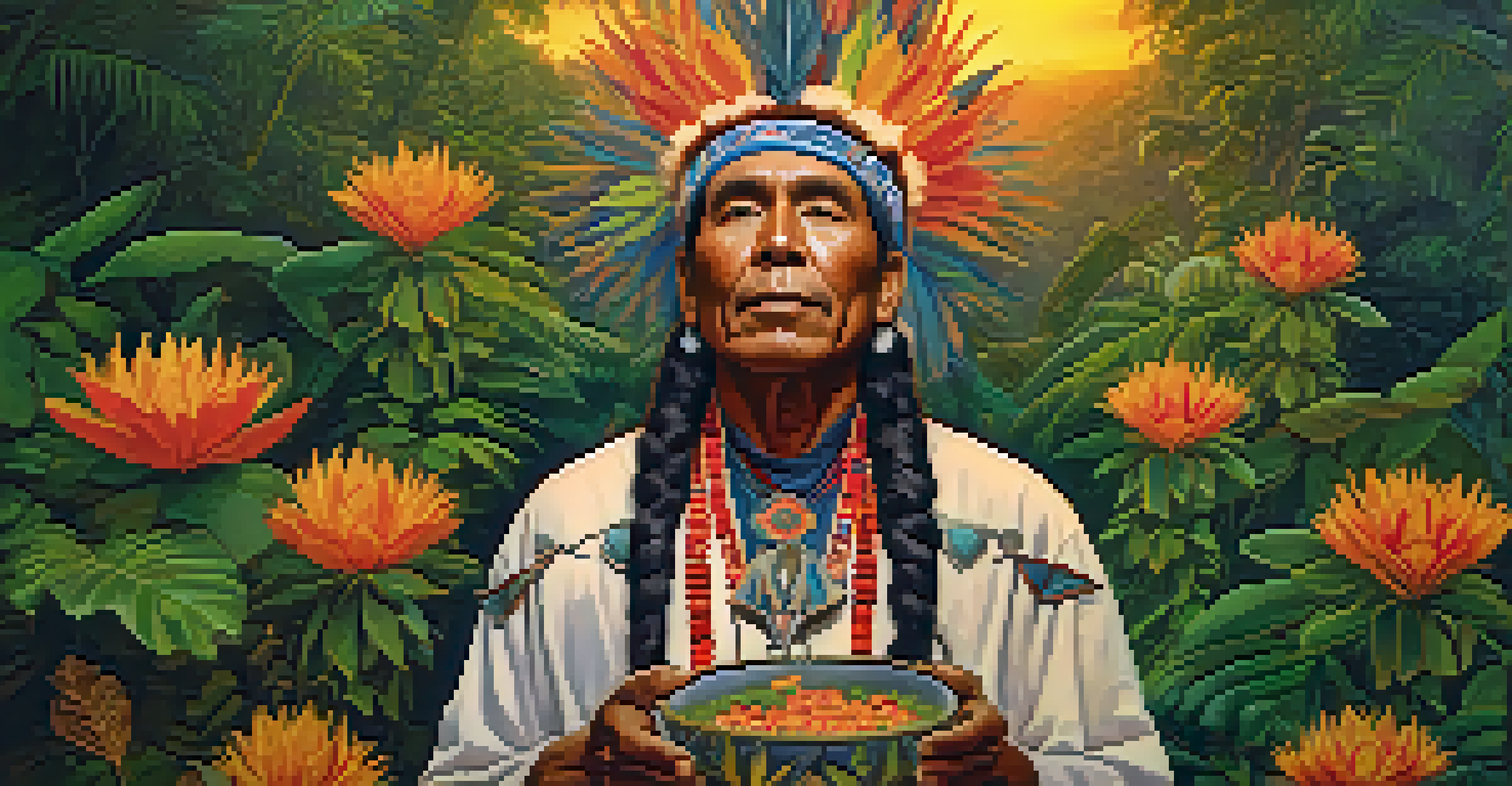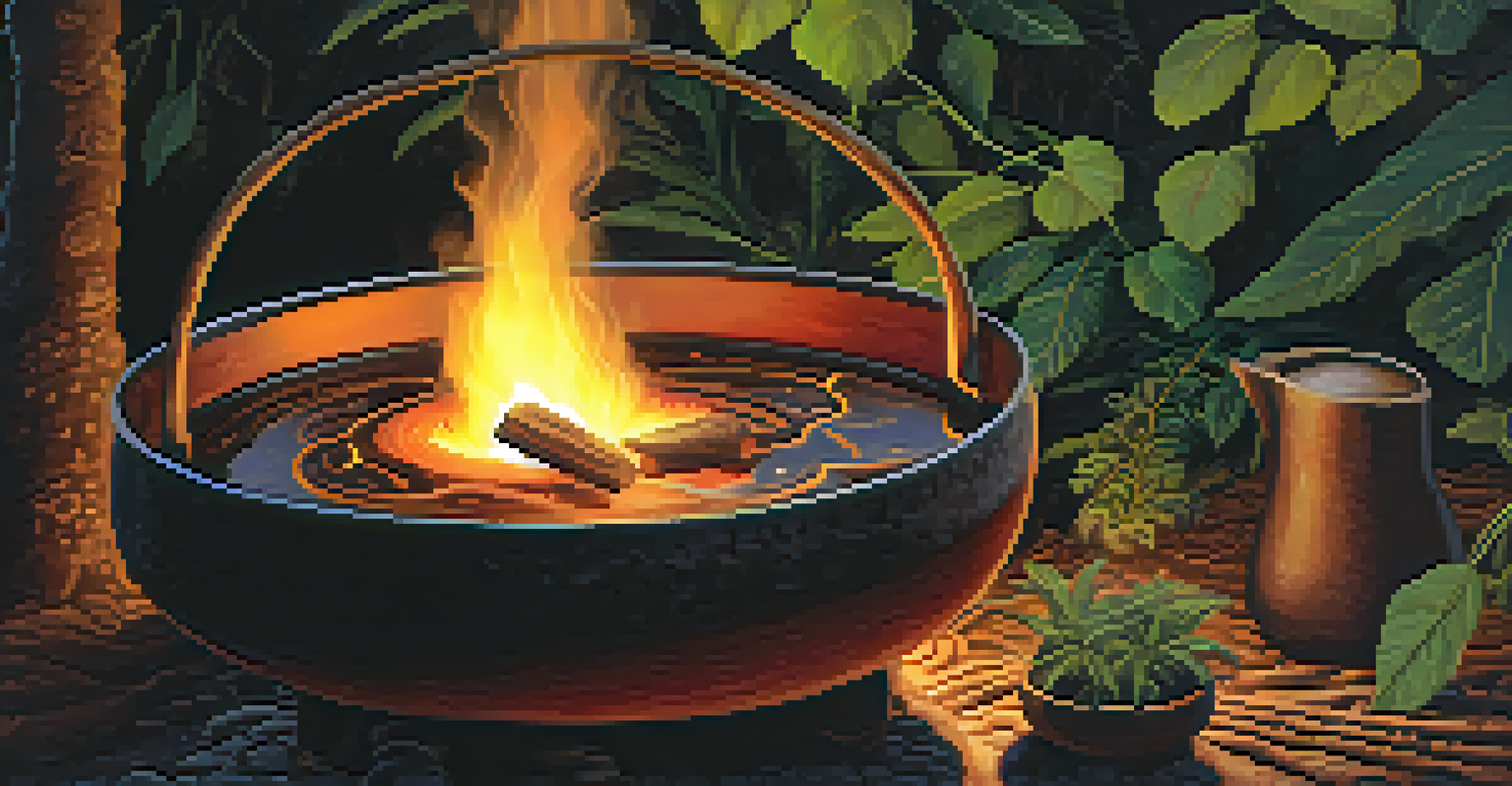Traditional Ayahuasca Preparation: Methods and Cultural Significance

Understanding Ayahuasca: Origins and Ingredients
Ayahuasca is a powerful brew made from the Banisteriopsis caapi vine and the Psychotria viridis leaf, both native to the Amazon rainforest. This combination has been used for centuries by indigenous cultures for spiritual and healing purposes. The active compounds in these plants, particularly DMT and MAO inhibitors, create a profound psychoactive experience, often described as a journey inward.
Ayahuasca is a gateway to understanding one’s place in the universe.
The origins of ayahuasca can be traced back to multiple indigenous tribes, each with its unique preparation methods and spiritual significance. These communities often view ayahuasca as a means to connect with the spirit world, gain insights, and foster healing. The brew is not merely a substance but a gateway to understanding one’s place in the universe.
Today, ayahuasca has gained global attention, attracting seekers from various backgrounds who are curious about its potential benefits. However, the cultural heritage behind its use is vital to respect and understand, ensuring that the practices remain authentic and rooted in their traditions.
The Traditional Preparation Process of Ayahuasca
The preparation of ayahuasca is a meticulous process that reflects the deep respect for the plants and their properties. Traditionally, the vine is harvested, stripped of its bark, and then pounded, while the leaves are collected and prepared separately. This labor-intensive work is often done communally, emphasizing the importance of community in this sacred practice.

After the ingredients are prepared, they are simmered together in water for several hours, creating a thick, dark liquid. This process can take anywhere from several hours to days, depending on the desired potency and the specific traditions of the group preparing it. It's a labor of love, requiring patience and attention to detail to ensure the brew is effective and safe.
Ayahuasca's Spiritual Heritage
Ayahuasca is a sacred brew used by indigenous cultures for spiritual connection and healing.
Once brewed, the ayahuasca is typically served in a ceremonial setting, often accompanied by prayers, chants, or music that enhance the experience. This holistic approach highlights the belief that preparation extends beyond the physical ingredients; it encompasses intention, spirituality, and community involvement.
Cultural Significance of Ayahuasca in Indigenous Communities
In indigenous cultures, ayahuasca is considered a sacred medicine, integral to their spiritual and healing practices. Shamans, or spiritual leaders, often facilitate ceremonies, guiding participants through their journeys with wisdom and care. This role is crucial, as they are seen as mediators between the physical and spiritual realms.
The future of ayahuasca preparation will depend on how well we honor its traditions while navigating contemporary contexts.
The ceremonies often take place in the heart of the jungle, surrounded by nature, which participants believe enhances the connection to the spirit world. During these experiences, individuals may receive visions or insights that guide them in their personal lives, promoting emotional healing and self-discovery. This connection to nature reinforces the deep-seated belief that everything is interconnected.
Moreover, these practices foster a sense of identity and continuity for indigenous communities, helping to preserve their cultural heritage. As modern society becomes increasingly disconnected from nature, the ayahuasca tradition serves as a reminder of the importance of spirituality, community, and respect for the environment.
The Role of the Shaman in Ayahuasca Ceremonies
Shamans play a pivotal role in ayahuasca ceremonies, acting as guides and healers for those partaking in the experience. Their extensive training, often involving years of apprenticeship, equips them with the knowledge to navigate the complexities of the journey. This expertise is essential for creating a safe and supportive environment for participants.
During the ceremony, shamans often sing icaros, traditional songs that are believed to invoke spirits and set the tone for the experience. These songs are not just entertainment; they serve a purpose in guiding participants through the often challenging emotional landscapes they may encounter. The shaman’s presence and guidance provide a sense of security amidst the intensity of the experience.
Role of Shamans in Ceremonies
Shamans guide ayahuasca ceremonies, providing essential support and insights for participants.
Additionally, the shaman’s role is deeply rooted in the community, as they are responsible for the well-being of participants both during and after the ceremony. Their insights and interpretations can help individuals process their experiences, fostering healing that extends beyond the ceremonial space.
Modern Adaptations of Ayahuasca Preparation
In recent years, ayahuasca has gained popularity outside indigenous communities, leading to various modern adaptations of its preparation and use. Retreat centers worldwide now offer ayahuasca experiences, often aimed at personal development and healing. However, these adaptations can sometimes stray from traditional practices, raising concerns about cultural appropriation.
Many modern facilitators emphasize the importance of respecting the traditions and teachings of indigenous cultures. This includes sourcing ingredients ethically and ensuring that ceremonies are conducted with the same reverence as they would be in their original contexts. By honoring these traditions, practitioners can help preserve the cultural significance of ayahuasca.
However, it’s crucial for participants to approach these modern adaptations with caution. The lack of regulation and varying levels of expertise among facilitators can lead to unsafe experiences. Engaging with authentic traditions and experienced shamans is essential for ensuring a meaningful and respectful experience.
Potential Risks and Considerations of Ayahuasca
While ayahuasca can offer profound insights and healing, it is not without its risks. The psychoactive properties of the brew can lead to intense emotional and psychological experiences, which may be overwhelming for some individuals. Participants should be aware of their mental health conditions and consult with a healthcare professional before engaging in ayahuasca ceremonies.
Additionally, the physical effects of ayahuasca can include nausea, vomiting, and diarrhea, often referred to as 'purging.' This purging is seen by many as a necessary part of the healing process, but it can be distressing. Understanding these potential side effects is crucial for anyone considering this journey.
Modern Adaptations and Risks
While ayahuasca's popularity grows, modern adaptations can pose risks if cultural traditions are not respected.
Lastly, participants should research and choose their retreat centers carefully, ensuring that they prioritize safety and ethical practices. Engaging with experienced facilitators who respect the cultural roots of ayahuasca can help mitigate some of these risks, creating a safer environment for exploration and healing.
The Future of Ayahuasca Preparation and Its Cultural Impact
As interest in ayahuasca continues to grow globally, its future will likely involve a blend of traditional practices and modern interpretations. This evolution presents both opportunities and challenges for maintaining the integrity of indigenous practices. Advocates emphasize the importance of education and awareness to ensure that ayahuasca remains a sacred experience rather than a mere commodity.
The ongoing dialogue between indigenous communities and modern participants is vital for fostering understanding and respect. By sharing knowledge and experiences, both groups can benefit from each other's perspectives, enriching the practice and preserving its cultural significance. This collaborative approach can lead to a more profound appreciation of ayahuasca’s roots.

Ultimately, the future of ayahuasca preparation will depend on how well we honor its traditions while navigating contemporary contexts. By prioritizing respect, safety, and genuine connection, we can ensure that the spirit of ayahuasca continues to thrive in both traditional and modern settings.